Getting in quality forearm workouts at home doesn’t mean spending tons of cash on equipment or doing weird exercises. In fact, by following this guide on how to get big forearms at home, you can achieve the same gains that you would by lifting weights in a gym.
After all, your muscles respond to and grow from tension; they have no idea what pounds or kilos are.
Now that said, I know that we all have different equipment at home. For example, I have access to dumbbells and bands. However, you might not have access to any weights whatsoever.
If that’s the case with you, then I’ve got you covered. As well as showing you various methods for performing forearm exercise at home with minimal equipment, I’ll also show you how to work out forearms without weights of any kind.
This guide is split into 3 distinct sections. We’ll begin by first learning how to work out the forearms at home (with and without weights). Then, we’ll get into the specific forearms exercises at home that you can do for the best results. And finally, I’ll share some amazingly effective sample routines so that you can get on with making those gains ASAP.
Related: Biceps workout at home │ Bicep workouts without weights
How to get bigger forearms at home
When you’re doing forearm workouts in the gym, it’s tempting to lift as much weight as you possibly can, often in an attempt to impress other gym-goers. However, more often than not, this ego-first, form-last technique results in injury and poor muscle stimulation.
The great thing about training at home is that (most likely) nobody’s watching you, besides maybe your dog. As such, you won’t feel pressured to show off and ego-lift, which means that the gains will come much more naturally. Plus, there can be great health benefits to at home training when paired with a healthy diet. [1]
Focus on your form
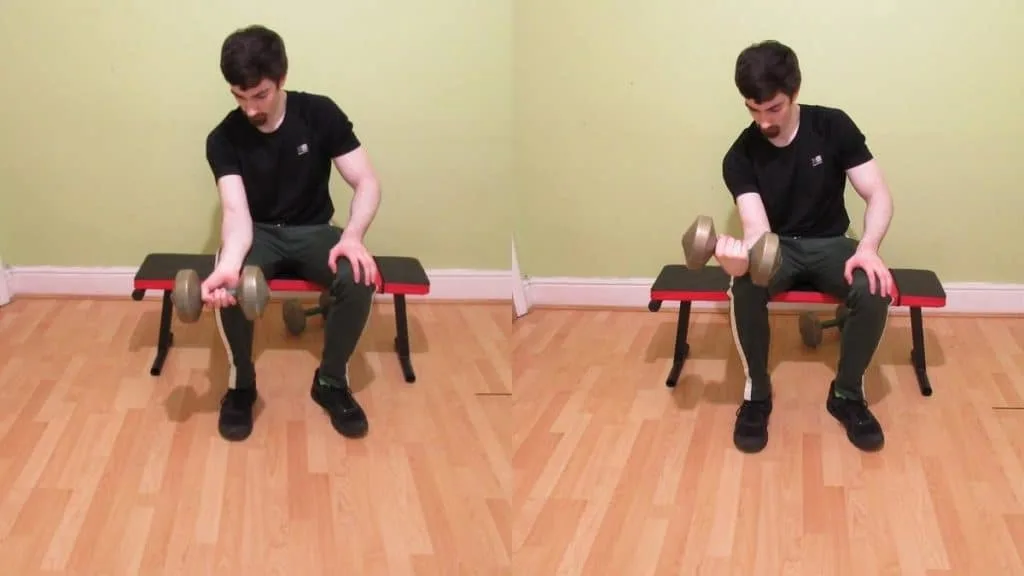
While there’s no such thing as easy forearm workouts if you train hard, you might be surprised at just how challenging light weights can feel.
I like to hold a dumbbell (or fill a backpack with some books) and then place my forearm on my thigh. From there, I simply allow the weight to move my hand forward and backward to stretch my forearms. This is called a forearm curl, and you’ll learn how to perform it at home—with and without weights— in just a sec.
You can also do this with bands (see our resistance band forearm exercises guide for more info). You sit down and hook the band around your feet (double loop it) and then hold the other end with one hand. With this setup, you basically have your very own cable machine, which means that you also get an incredible pump due to the consistent tension.
The trick is to start light and stay light until you master the form. From there, you can add weight. But it’s completely optional—even if you’re dead set on gaining size.
You see, as I said in the intro, the forearms only respond to tension. Adding weight is one way to increase the tension, but slowing down each rep by 1 second is another effective method for doing the same thing.
Also, consider squeezing your forearms harder, doing extra reps, or shortening your rest periods. These are all forms of progressive overload, and they don’t require you to sacrifice form for weight or vice versa.
Lift household objects
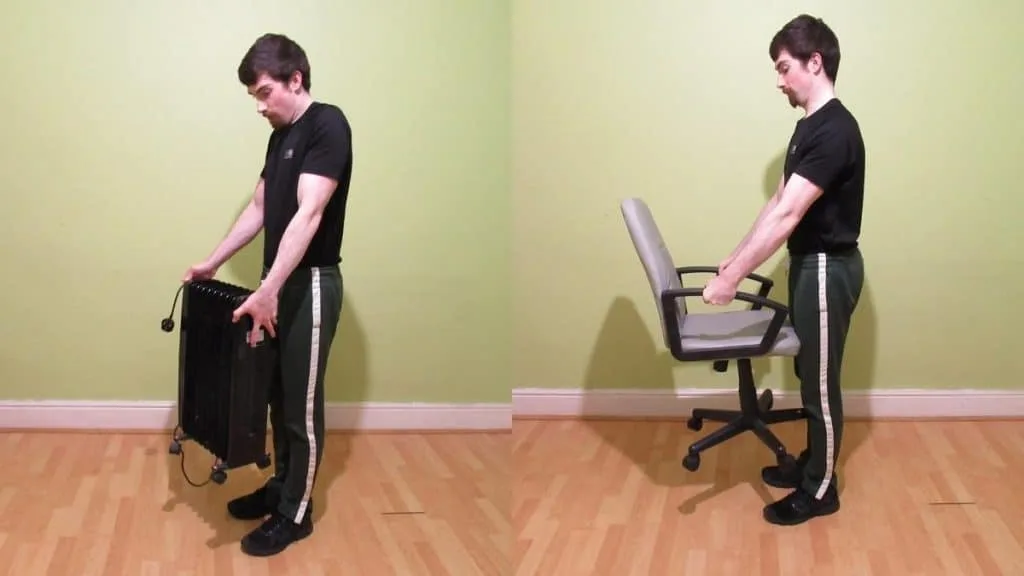
Doing your forearms exercise at home doesn’t mean that you need to start hoisting fridges and washing machines—leave that to the removal men. However, doing a forearm workout at home with no equipment does mean that you need to be that bit more inventive than you otherwise would be in a gym because the equipment might not exactly be staring you in the face at first glance.
But what about that heavy water bottle, the big 5L one?
You could use that for wrist curls, reverse curls, and farmer’s carries. Heck, you could use it for curls and shoulder presses too. The point is, these water bottles are widely available, insanely cheap, and I reckon that you could also fill them with sand for even more resistance.
Tubs of paint are another fantastic, easy-to-lift option for forearm curls.
However, you can hold any weighty household object in your hands and see results. Seriously, even holding a 15lb vacuum cleaner or a 20lb backpack with books inside will set your forearms on fire if you hold them for long enough.
Plus, with these static hold exercises, you’re not just building forearm size; you’re also building tremendous grip strength. And it’s much more effective for muscle growth than household chores (and more fun, too). [2]
Buy some basic equipment
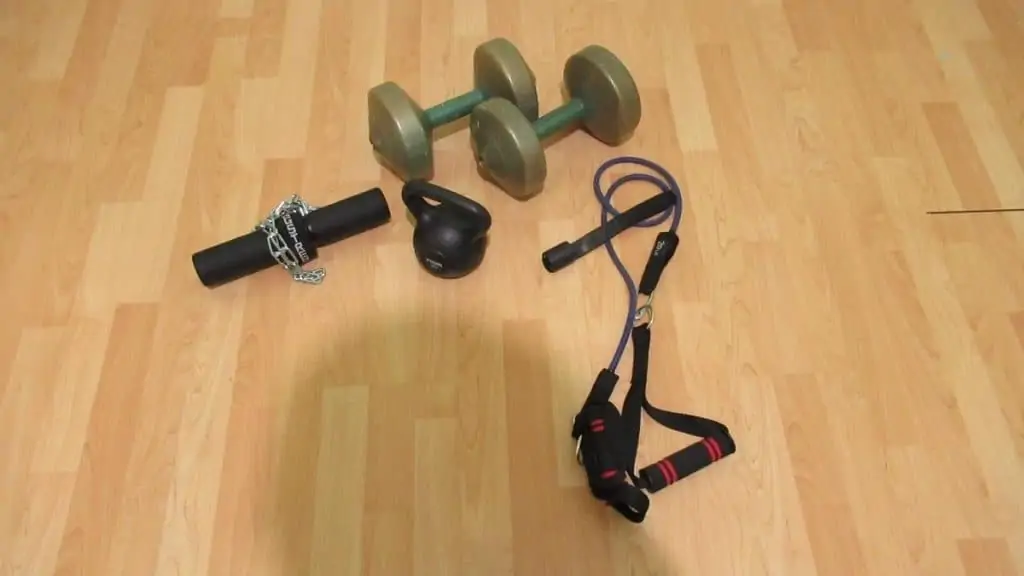
It’s completely possible to do home forearm workouts with zero gym equipment. However, since not all objects are as convenient to lift as weights, investing in some dumbbells and resistance bands will go along way to making your at home forearm workout that bit easier (but no less challenging).
You don’t need to spend loads of money. Dumbbells are pretty affordable these days if you don’t get sucked into buying the adjustable ones. Get around 30-65lbs per dumbbell so that you can use them for other exercises, and also pick up some bands to work the areas that free weights can’t.
Of course, weights are entirely optional. I’m also going to show you how to strengthen forearms without weights in just a second, too.
See Also: Tricep workouts without weights
How to get bigger forearms without weights
If you want to learn how to build forearms without weights of any kind, then this section is for you. By using household objects and your imagination, you’ll soon get bigger forearms at home that rival those that you could build in a gym.
Use your body as a gym
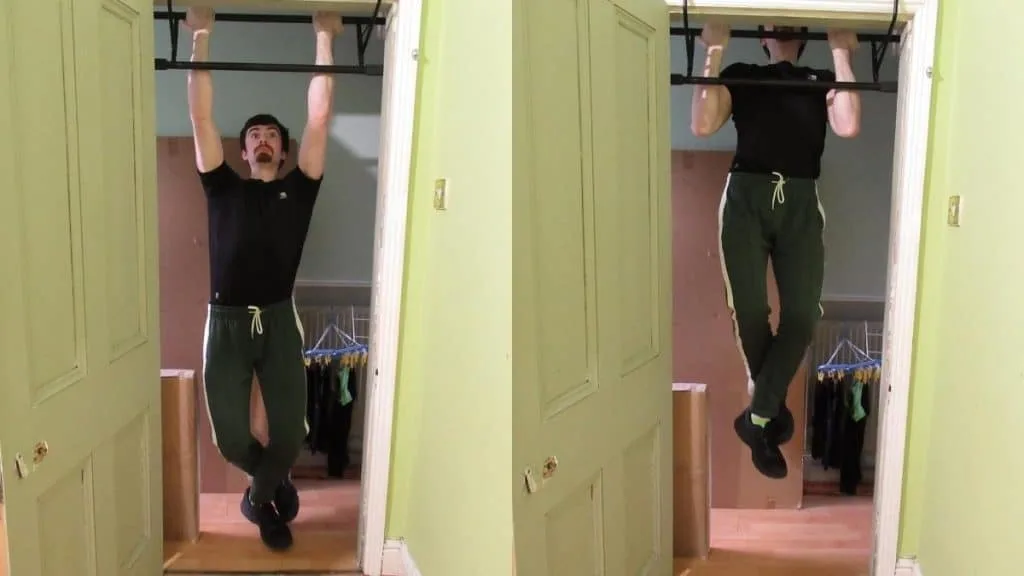
Anyone with a strong grip usually has the forearm size to match. Climbers are a great example of this kind of person, and their backs aren’t bad either.
What we can learn from climbers is this: Work on your grip endurance if you want to build your forearms.
You could buy a doorway pull up bar for maximum convenience. But any metal bar or sturdy tree branch that can support your weight offers the same workout possibilities.
The key is to grip the bar tightly with the palms of your hand, only allowing your fingers to take the strain as your forearms tire. At first, aim to maintain this dead hang position for 30 seconds. Then bump it up to one minute.
If you’re doing this drill with a pull up bar, then you can also wear a backpack with books inside to increase the difficulty.
Read more: bodyweight forearm exercises
Don’t neglect your grip
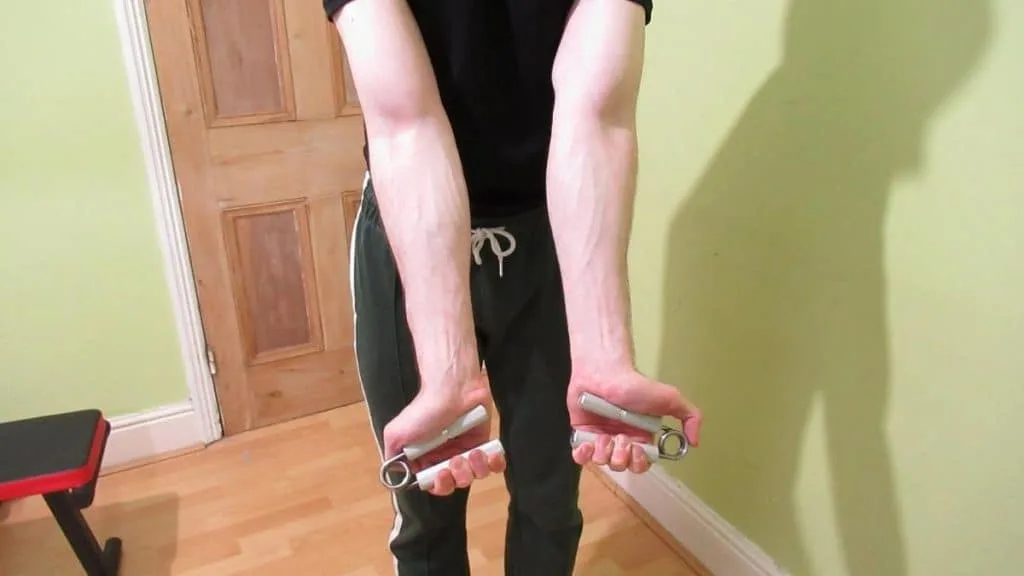
As I just mentioned, the grip is critical when it comes to building forearms without weights of any kind. However, there are more ways to train your grip than with a backpack (though that is one of my favorites).
Another excellent option for a forearm workout without weights is to hold two tubs of paint or large water bottles in each hand for 60-90 seconds with a supinated or neutral grip. [3] Alternatively, fill some shopping bags with a few bottles of milk, bags of oats, etc.
The benefits here are that it’s convenient, you’re improving your grip more than you would at the gym, and you’re getting those forearm gains as well. So yes, carrying the shopping bags is great for the lower arms if you do it for a prolonged period of time.
Fill up a backpack
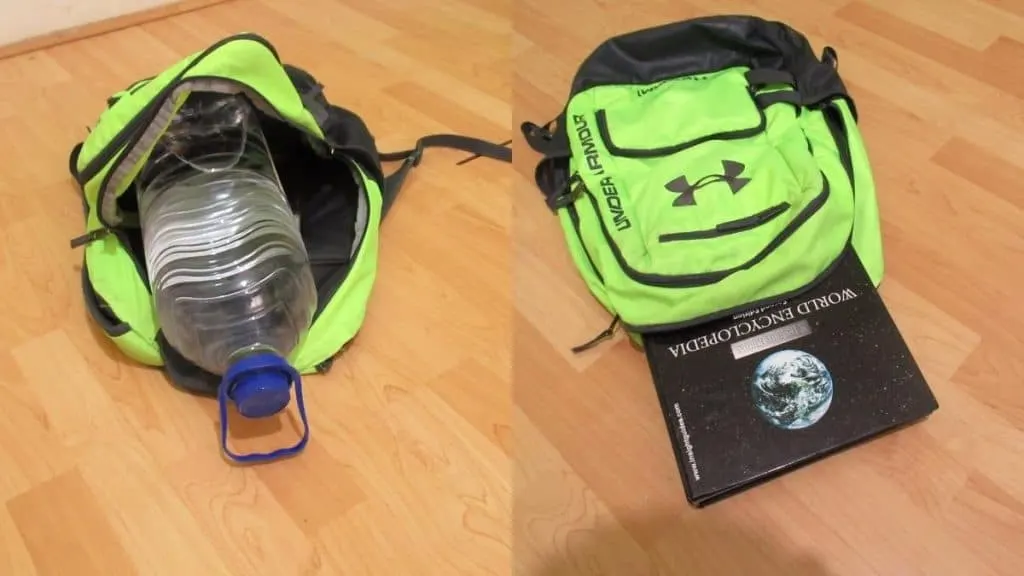
A backpack is a phenomenal tool for making dead hangs (and push ups) more difficult.
But did you know that you can also use it for wrist curls?
I have a full section on this down below, so I won’t spoil it now. But essentially, you hold the “hook” part of the backpack and use that as the dumbbell handle. This material is generally soft on the skin, and it allows the rucksack to stretch out your forearms just like a dumbbell does.
Related post: backpack forearm workout
Forearm exercises at home
Check out these killer training drills if you want to learn how to get bigger forearms at home for yourself. Sure, you need weights, but that’s simply what’s most convenient for lifting.
The next section has various forearm exercises without weights of any kind. So feel free to skip ahead if you’re working with limited or no equipment.
Dumbbell wrist curl
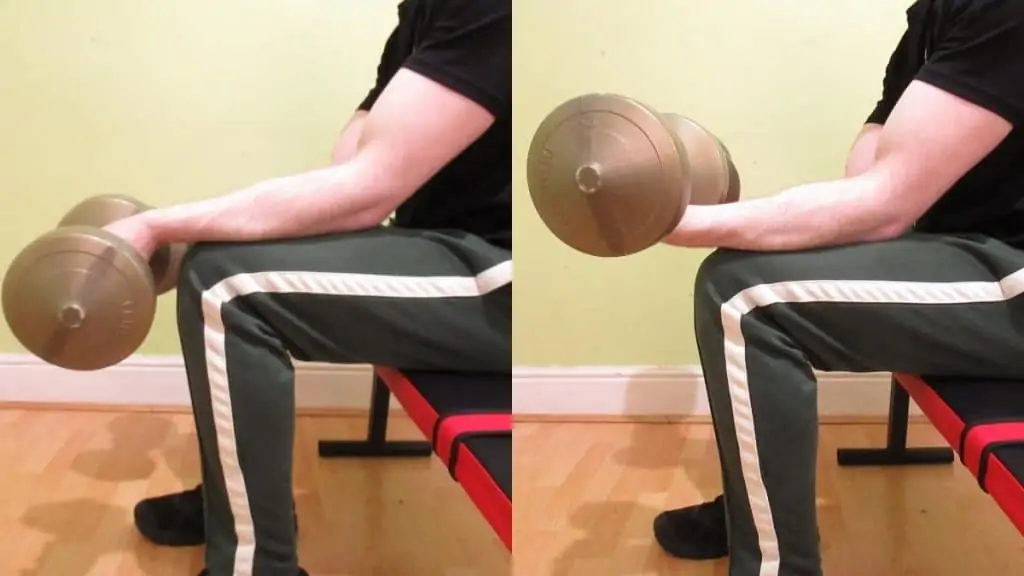
I like the dumbbell wrist curl because you can start light and easily add weight as you gain strength. Also, you don’t need any fancy weight benches to do it.
Hold a dumbbell in one hand while sitting in a chair or on the sofa. Then, place your lower arm, palm up, on your thigh. Alternatively, rest your forearm on a desk or table and let your hand hang off the edge.
From here, lower the weight towards the ground until you feel a comfortable stretch. Then, lift the weight back up by flexing your wrist. Hold the contraction for a split second and then repeat for another 10-20 reps.
Also, don’t forget to work your extensors by doing the drill in a palms-down position (you’ll need to lighten the weight for this).
Read more: dumbbell forearm exercises
Barbell wrist curl
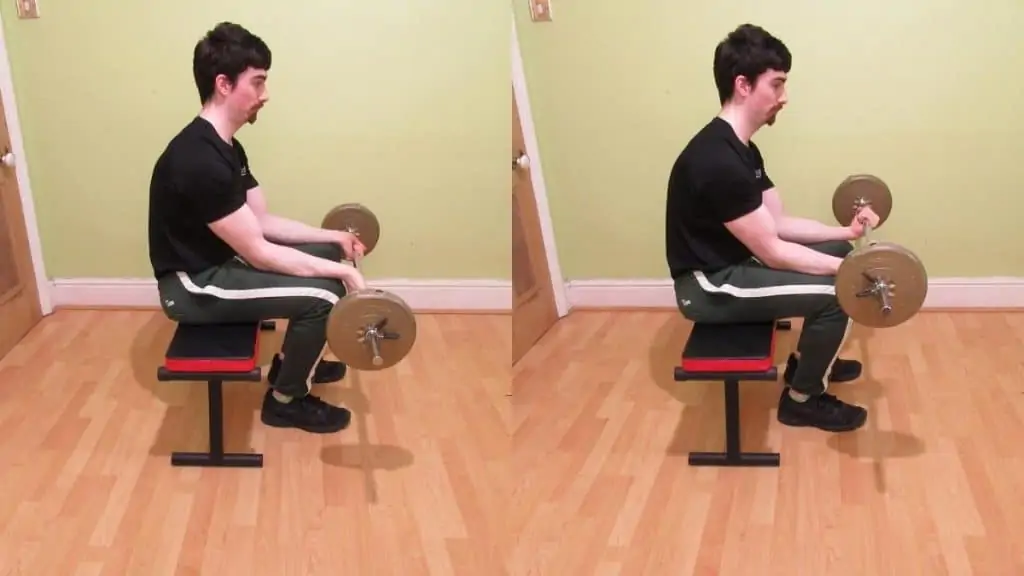
While the setup for the dumbbell version is more convenient when you train at home, the barbell wrist curl does allow you to complete your workout faster by training both arms at once.
Again, you’ll either want to do this on a table or place your lower arms on your thighs. From there, the form is exactly the same as the dumbbell version. You lower the bar towards the floor until you feel a nice stretch and then raise it back up by flexing your wrists.
Wrist roller
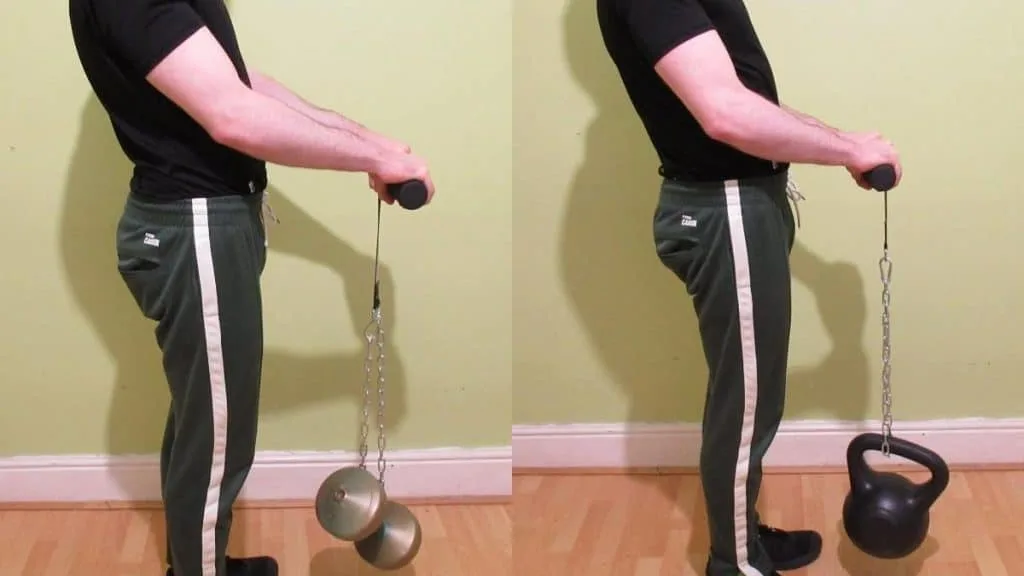
The wrist roller exercise is an old-school bodybuilding movement that builds thick, meaty forearms without the need to do any other exercises.
So if you want to make gains with limited equipment, this exercise is a great option. You’ll need to buy weights to attach to the device. However, if you’re a novice at this exercise, then even 10lbs can feel quite challenging when you’re doing multiple sets.
Plate pinch
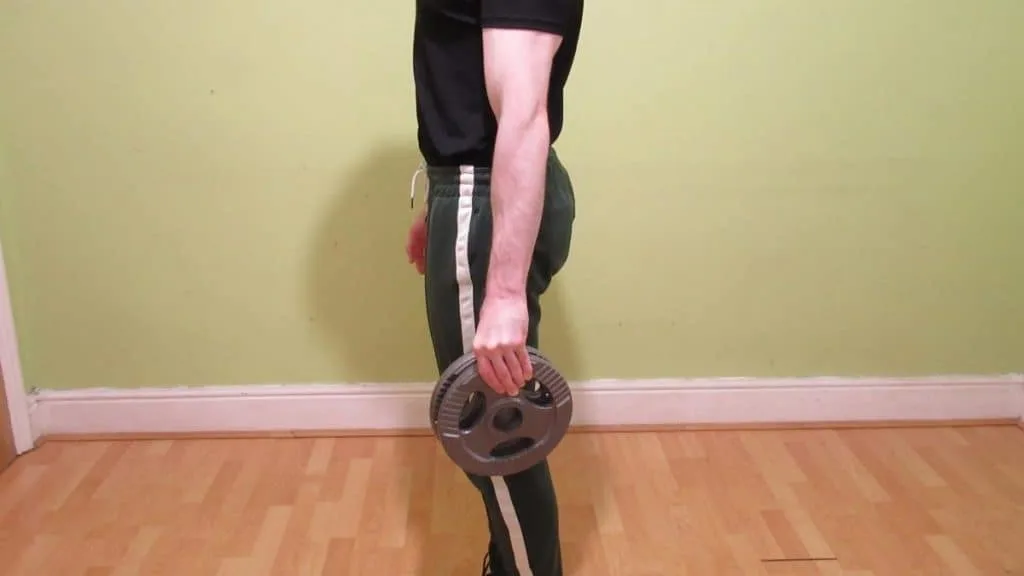
Plate forearm curls are a convenient substitution for dumbbell forearm curls if you only have access to a barbell and some weights. However, holding a plate between your thumb and fingers will activate forearm muscles that you didn’t even realise you had.
The forearms consist of so many small muscles (much more than the biceps) that you’ll never achieve full development until you do some kind of drill that involves the pinching muscles, namely, the thumb and fingers.
Try to hold the plate(s) between your fingers and thumb for 15-30 seconds. Once again, you can replace the plate with any similar household object that you can easily pinch.
Forearm exercises without weights
Before we get into the specific forearm workouts without weights that you can do at home, let’s learn how to do the individual exercises for the fastest and best results.
Pull up bar holds
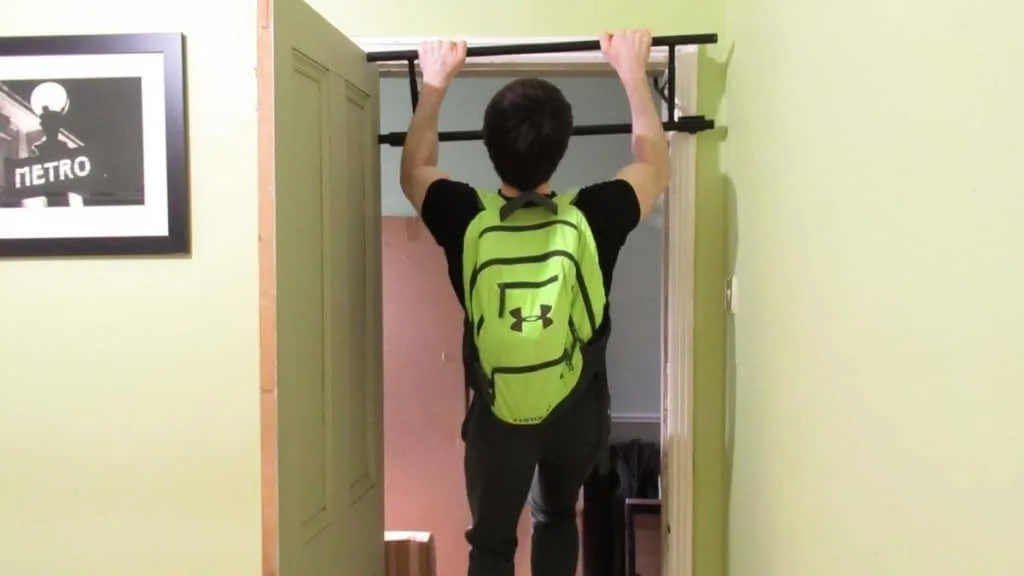
As mentioned, pull up bars are cheap and convenient. However, you can do this drill with equipment in the park, on some soccer goal posts, or on a sturdy tree branch if you want to feel like Tarzan.
The idea is to grip the bar firmly and then hold on for as long as you can. However, be sure to keep your back somewhat engaged. This doesn’t mean that you actually need to perform a pull up motion. But it does mean that you should avoid completely shrugging your shoulders up because this can hurt your rotator cuffs.
See also: shoulder and forearm workout │forearm workout for women
Backpack wrist curls
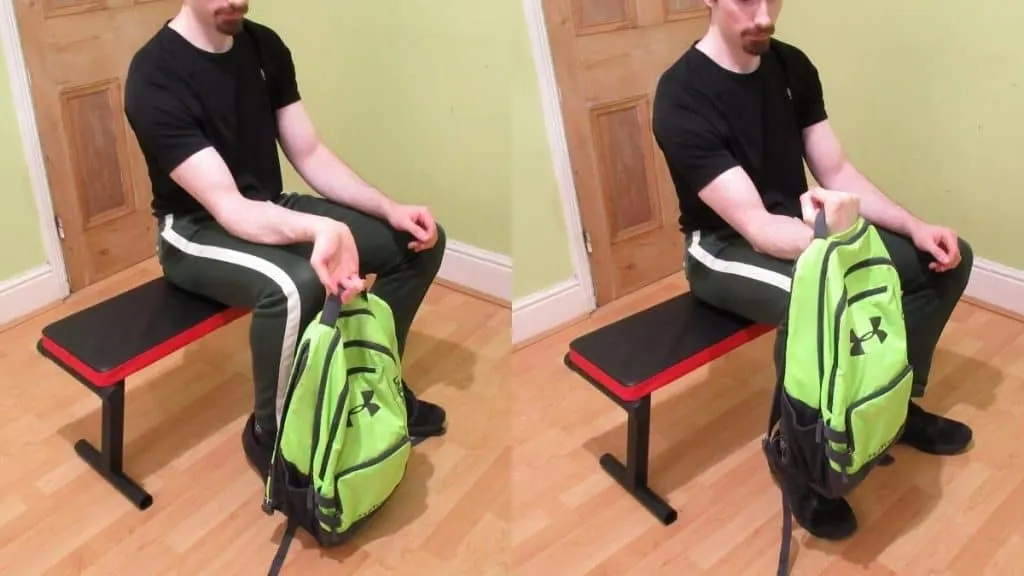
Fill a backpack with some books or any weighty household object. Then, sit comfortably in a chair or on the sofa and then hold the top/hook part of the backpack in one hand while you rest that arm on top of your thigh.
From here, you want to lower the backpack towards the ground as if you were doing wrist curls with weights. Then, once you feel a good stretch, flex your wrist to bring the bag back up.
You can also do this exercise standing up if the rucksack hits the floor while doing it in the seated position. The form is exactly the same; flex the wrist to work your forearm flexors, and extend your wrist to work the forearm extensors.
Water bottle carries
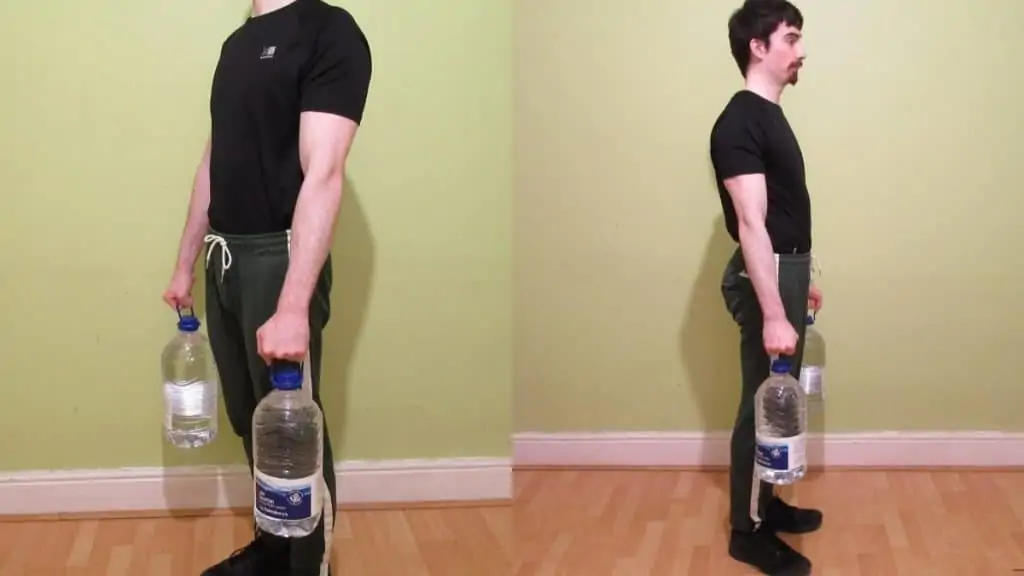
When it comes to the countless forearm exercises without equipment, water bottle carries/holds are my favorites. And that’s because they’re ultra convenient (you can do them while walking back from the shops). Plus, they simultaneously develop both grip strength and muscle size.
The form is exactly as you’d expect. You hold two heavy water bottles (5L or more ideally) in each hand and walk around the house or back from the shops. Alternatively, if you don’t like cardio, you can stand in the same position and just hold the bottles for as long as possible.
If you’ve not done this drill before, then prepare for a serious forearm burn. I first discovered this exercise by accident while carrying water bottles back from the store. My forearms were on fire, and my traps were even sore the next day. It’s a beast of a strength exercise if you ask me (or any strongman).
Forearm squeezes
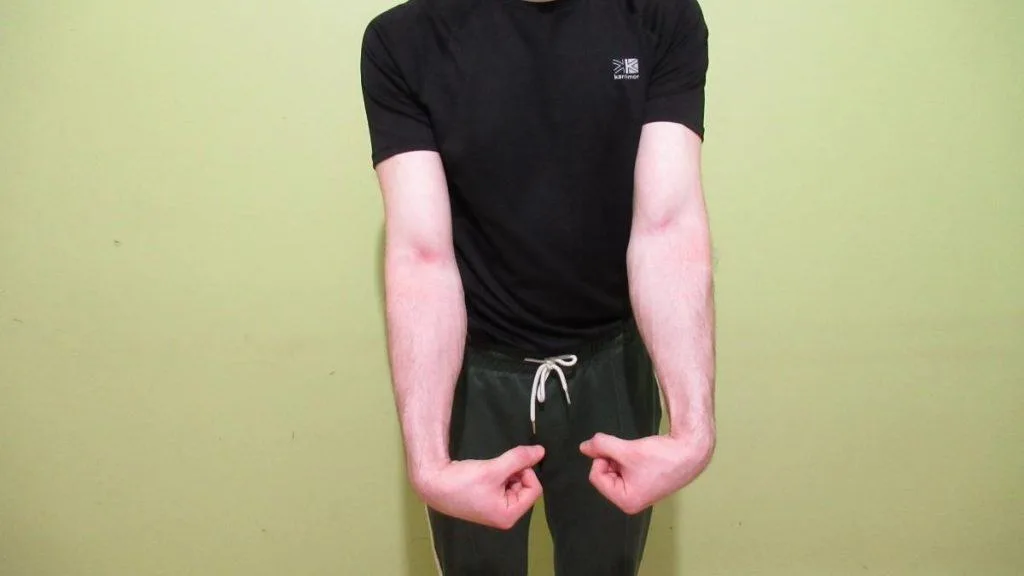
Yes, I’m actually talking about unweighted forearm squeezes. While this exercise alone won’t build much in the way of size, it’s surprisingly challenging to do at the end of an at home forearm workout.
Essentially, you rapidly contract and relax your forearm flexors until the pump becomes unbearable. Make sure to emphasize the contraction (really squeeze hard), but don’t worry too much about slowing down the eccentric part of the rep or anything like that.
Instead, focus on engorging the muscle with blood and achieving an almighty pump. It’ll really help to finish the muscle off while stimulating maximum growth by recruiting the remaining slow-twitch muscle fibers.
Plus, since we’re doing fast dynamic contractions (rather than just isometrics), we’re naturally stimulating muscle hypertrophy. [4] Now just imagine the gains if you do this drill with an actual hand gripper.
At home forearm workout routines
So now that we’ve seen all of the possible forearm exercises at home, it’s time to piece them all together into some workout routines. There’s one for each level of advancement. And as always, feel free to substitute exercises depending on the equipment you have available.
Related workouts: dumbbell forearm exercises │kettlebell forearm workout
Beginner home forearm workout
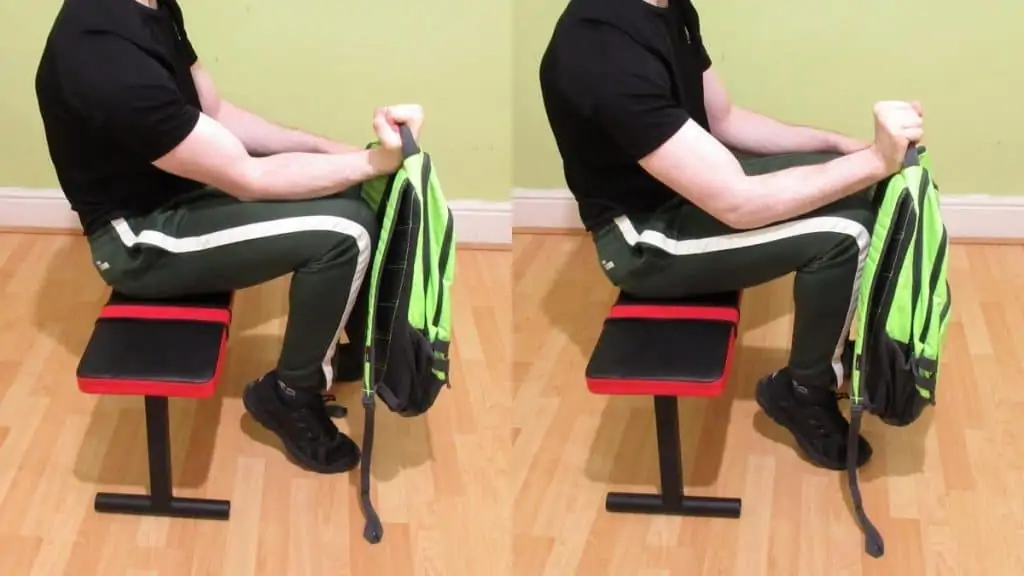
Even just 2 hard sets is enough training volume for a beginner to achieve great gains. This is especially true for a muscle group as small as the forearms.
1: Backpack wrist curl — 2 x 10-12 reps
2: Reverse backpack wrist curl — 2 x 12-15 reps
3: Reverse bicep curl (dumbbells or water bottle) — 2 x 8-12 reps
4: Static hold with bottles — 2 sets of 60 seconds
Best forearm workout at home for intermediates
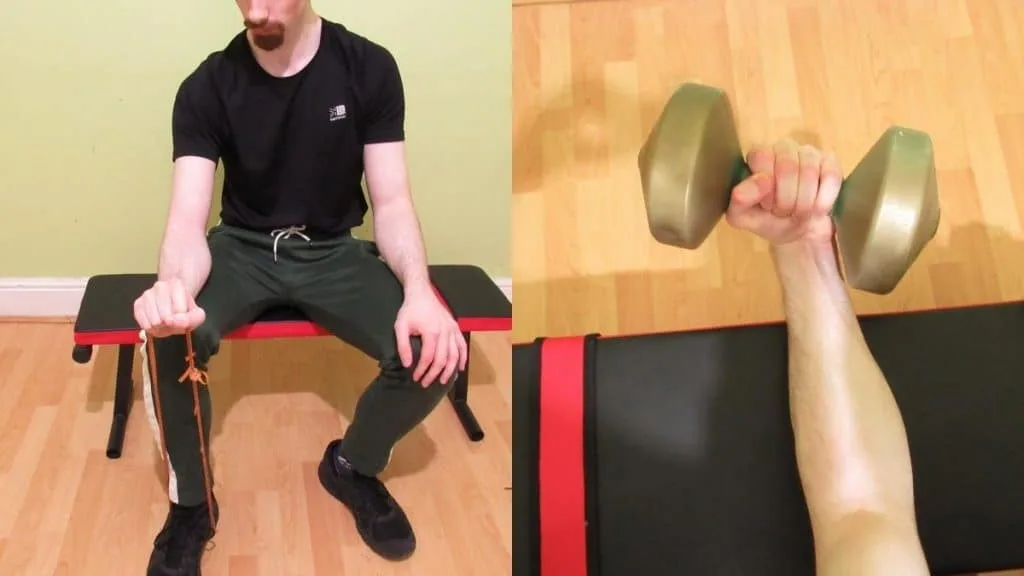
It’s time to increase the number of sets as you reach the intermediate stage. We’re doing 3 sets of each main movement and then finishing with the more challenging pull up bar holds, which require you to support your entire bodyweight.
1: Dumbbell wrist curl — 3 x 10-12 reps
2: Banded reverse wrist curl — 3 x 15-20 reps
3: Reverse arm curl — 3 x 8-12 reps
4: Pull-up bar holds — 2 sets to failure
Advanced forearms workout at home
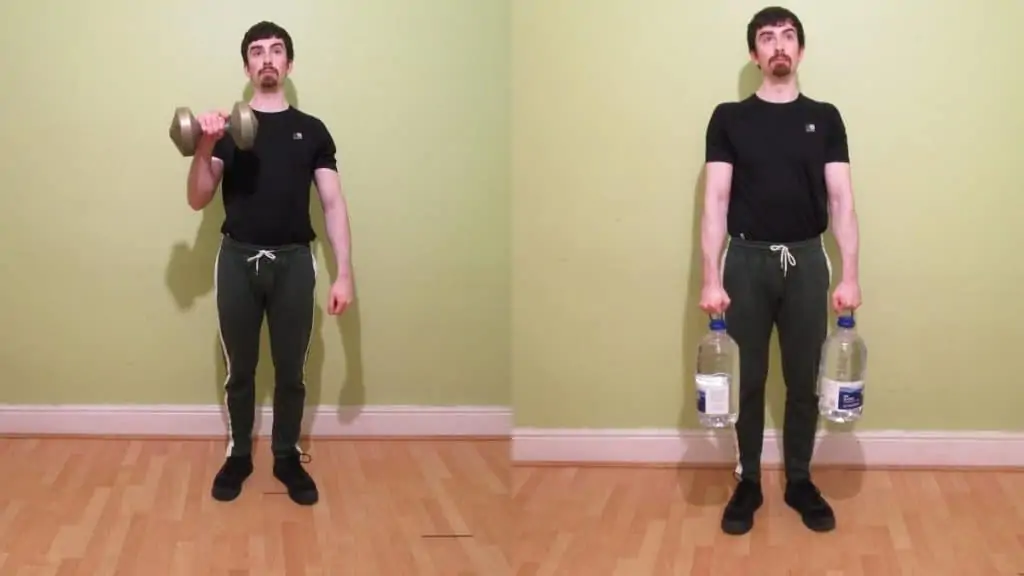
This workout might well be short. But let me tell you, it’s incredibly intense. The first time that you do this superset session, you’ll have DOMS for days. Few other routines produce such a skin-splitting pump with such minimal equipment.
1A: Dumbbell wrist curl — 4 x 10-12 reps
1B: Reverse dumbbell wrist curl — 4 x 15-20 reps
2: Reverse bicep curl — 4 x 8-12 reps
3A: Pull-up bar hold — 2 sets to failure
3B: Dumbbell/bottle farmer‘s carry — 2 sets to failure
Forearm workouts without weights
If you’ve been wondering how to get bigger forearms without weights, then these routines are for you. The beginner routine utilizes straight sets so that you don’t overstress your forearms. The advanced workout, however, once again uses supersets to allow for maximum training volume in the shortest possible amount of time.
Related posts: bicep and forearm workout │bicep tricep and forearm workout
Forearm workout no equipment (beginner/intermediate)
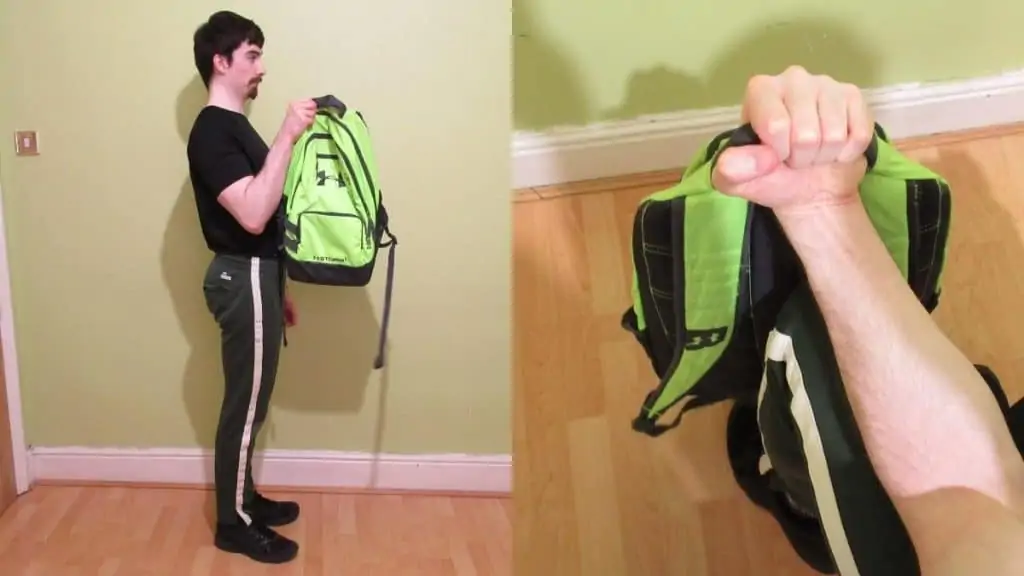
1: Rucksack wrist curl — 2 x 10-12 reps
2: Rucksack reverse wrist curl — 2 x 12-15 reps
3: Rucksack/bottle reverse bicep curl — 2 x 10-15 reps
4: Water bottle holds — 2 sets to failure
Forearm workout no weights (advanced/expert)
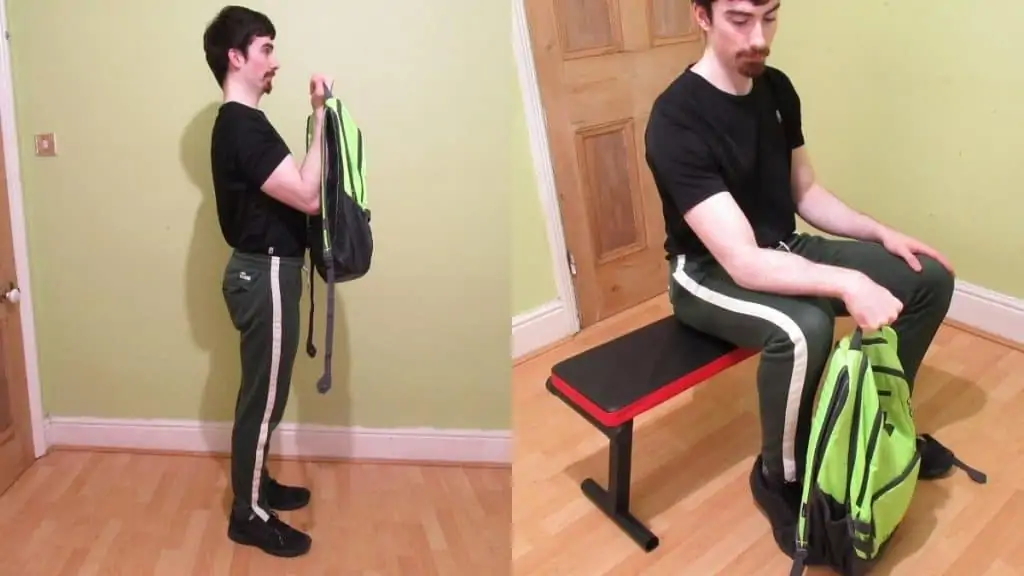
1A: Backpack wrist curl — 4 x 10-12 reps
1B: Backpack reverse wrist curl — 4 x 15-20 reps
2: Backpack/bottle reverse bicep curl — 4 x 8-12 reps
3A: Pull-up bar holds — 2 sets to failure
3B: Backpack/bottle farmers carry — 2 sets to failure
Conclusion: Is doing your forearm workouts at home a good idea?
We see so many people wondering how to get bigger forearms and wrists at home and asking what the perfect forearm workout at home is for them. The truth is, like any muscle, the humble forearms aren’t special—they grow from and respond to tension.
Backpacks, water bottles, shopping bags, and even tubs of paint are all great replacements for free weights. All you need is a moderate amount of imagination and the discipline to use good form.
As I’m fond of saying, there are countless forearm exercises at home that you can do (one or more for every household object). But eventually, they’ll all result in the same physique that’s determined by your genetic potential.
References
- Roberts, C., Segovia, D., & Lankford, D. (2019). Effects of Home-Based Exercise Training Systems, Combined with Diet, on Cardiometabolic Health. International Journal Of Exercises Science, 12(2), 871–885.
- Murphy, M. H., Donnelly, P., Breslin, G., Shibli, S., & Nevill, A. M. (2013). Does doing housework keep you healthy? The contribution of domestic physical activity to meeting current recommendations for health. BMC Public Health, 13(1). https://doi.org/10.1186/1471-2458-13-966
- Richards, L. G., Olson, B., & Palmiter-Thomas, P. (1996). How Forearm Position Affects Grip Strength. American Journal of Occupational Therapy, 50(2), 133–138. https://doi.org/10.5014/ajot.50.2.133
- Rasch, P. J., & Morehouse, L. E. (1957). Effect of Static and Dynamic Exercises on Muscular Strength and Hypertrophy. Journal of Applied Physiology, 11(1), 29–34. https://doi.org/10.1152/jappl.1957.11.1.29

